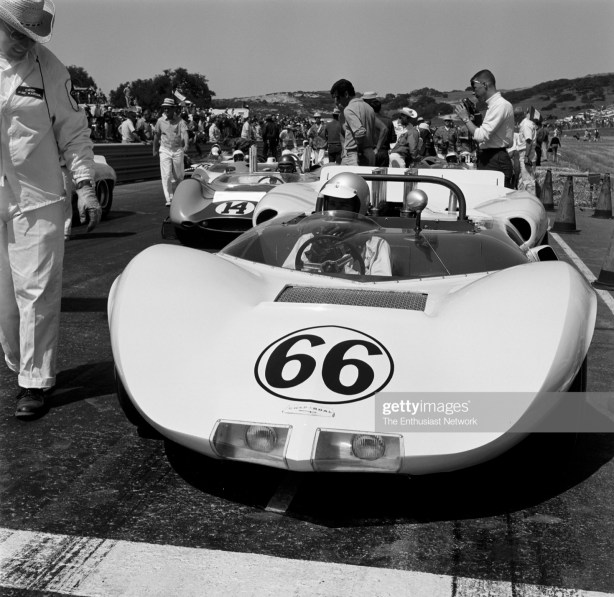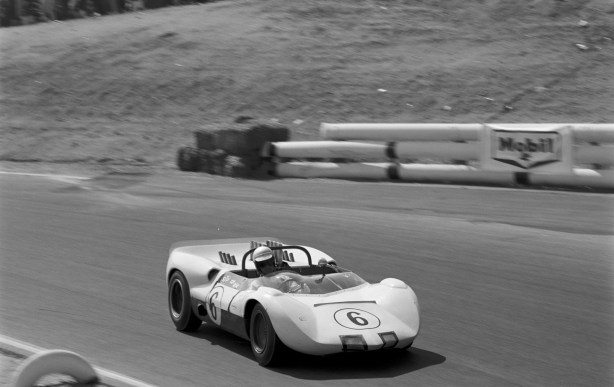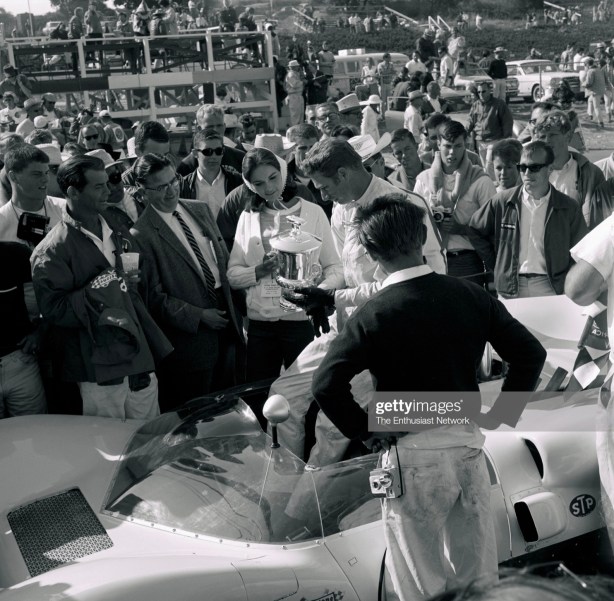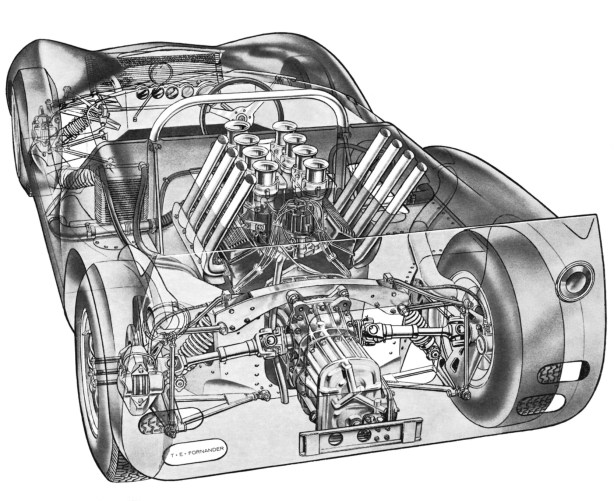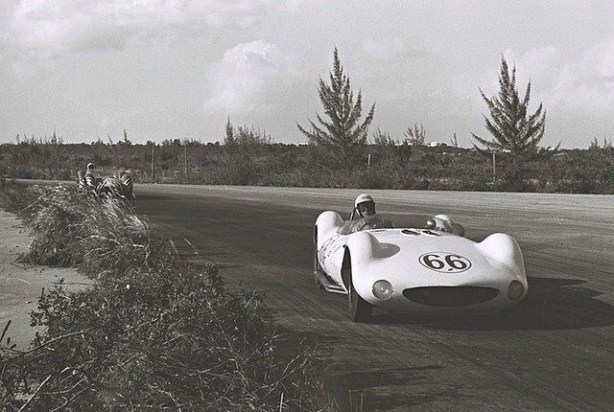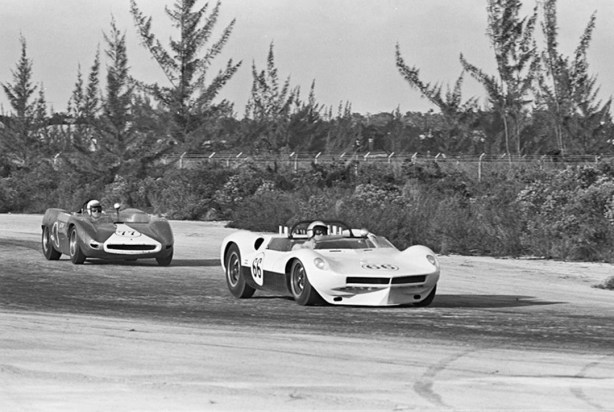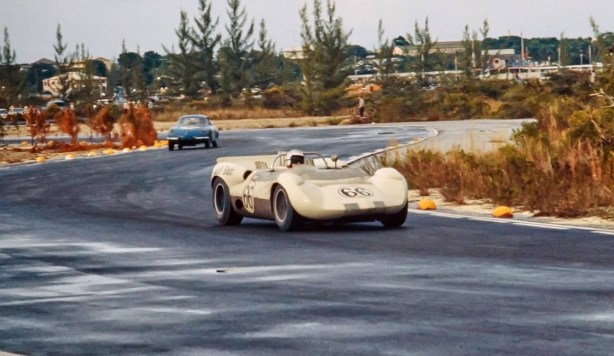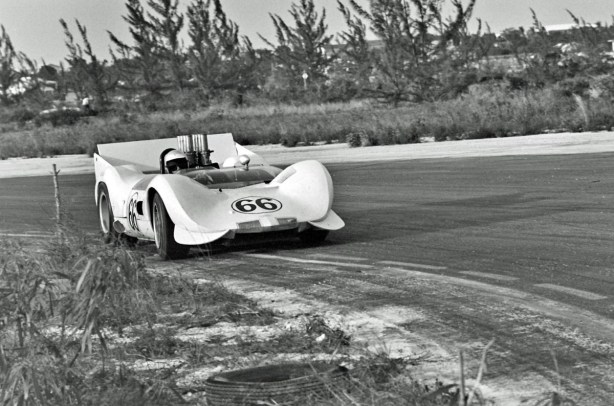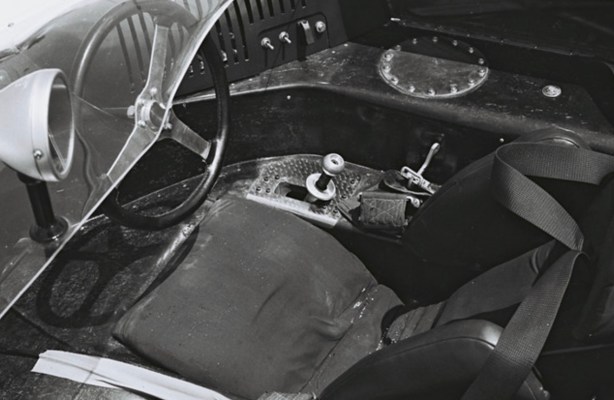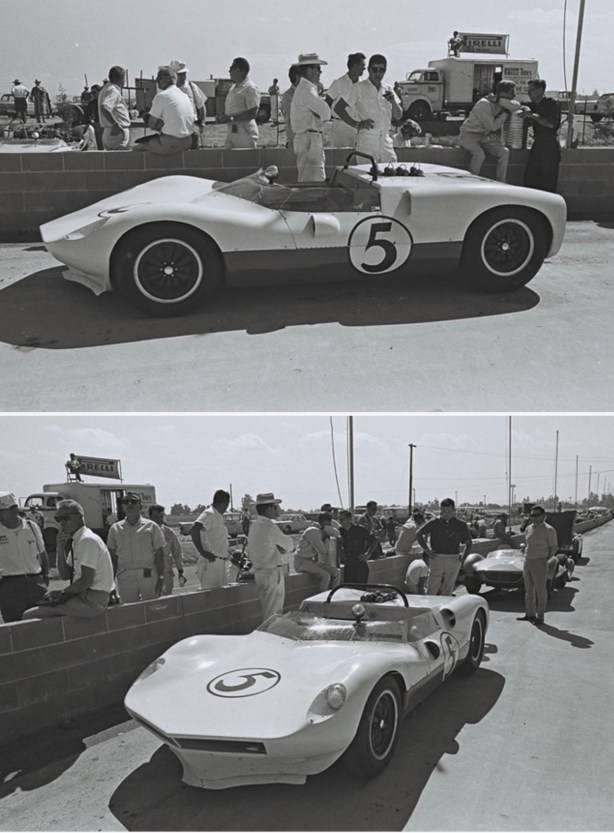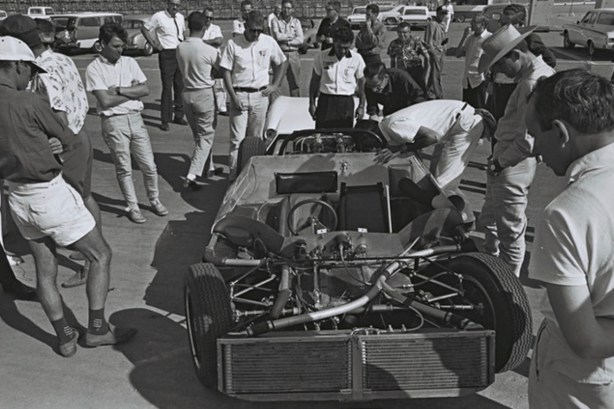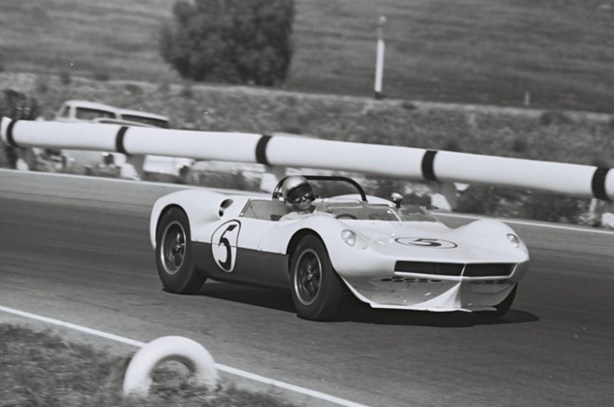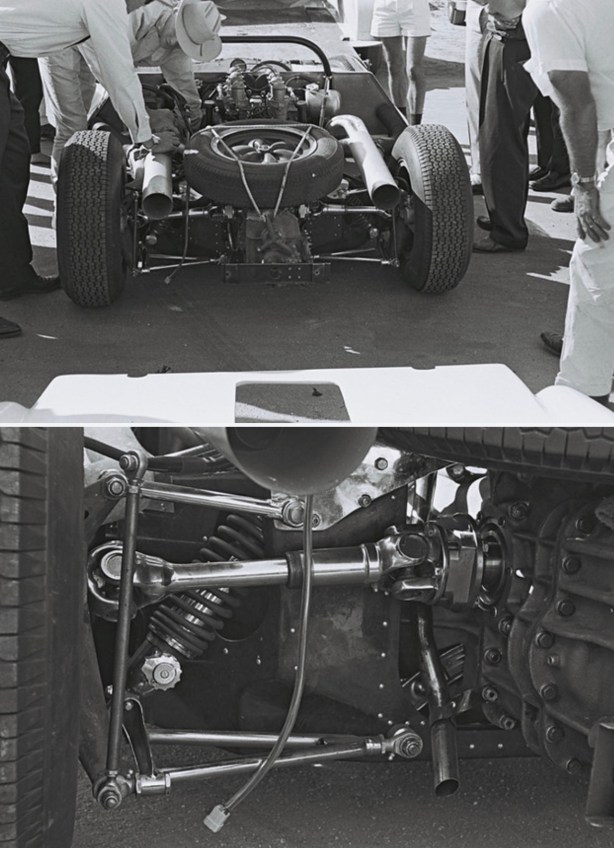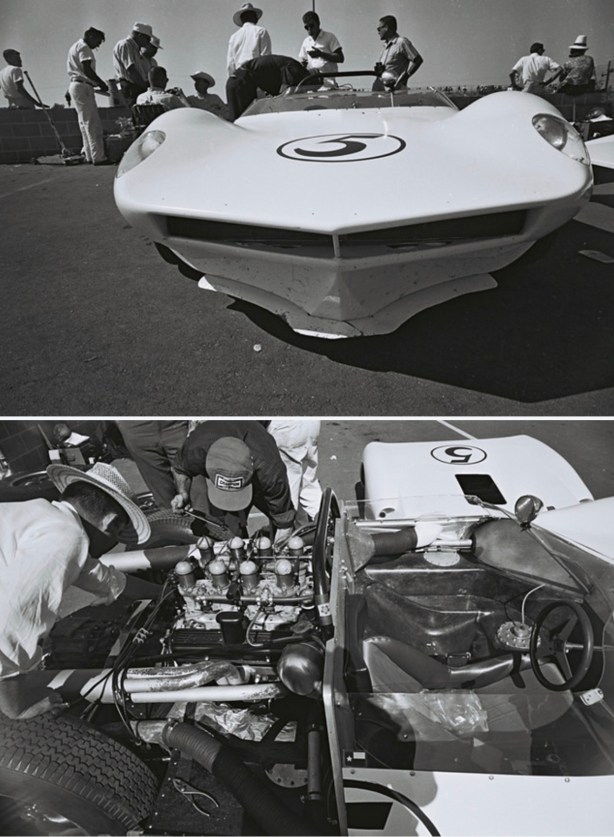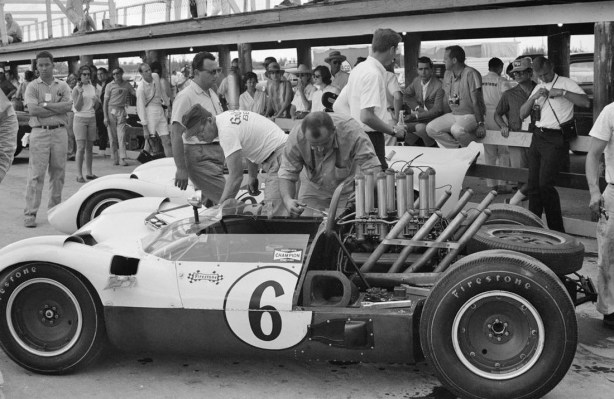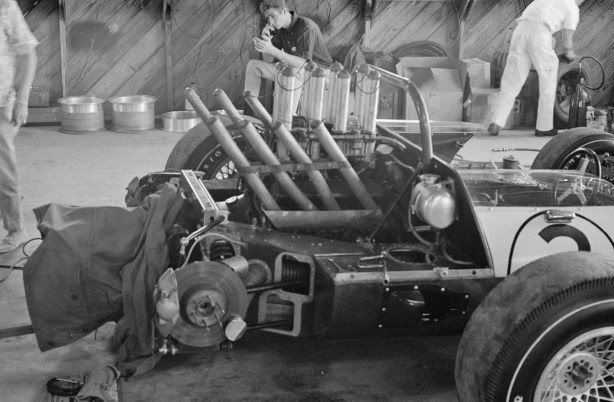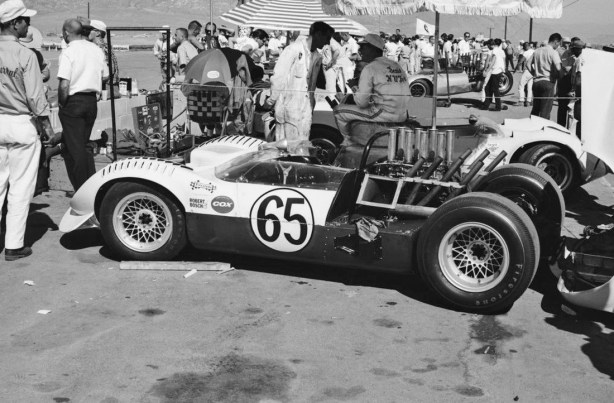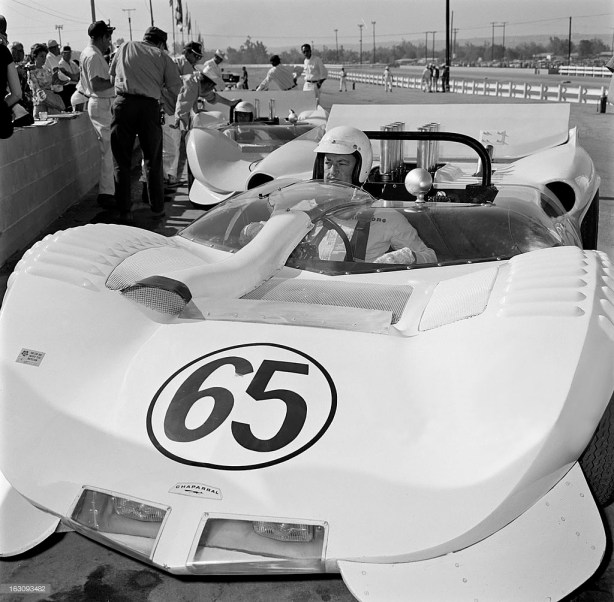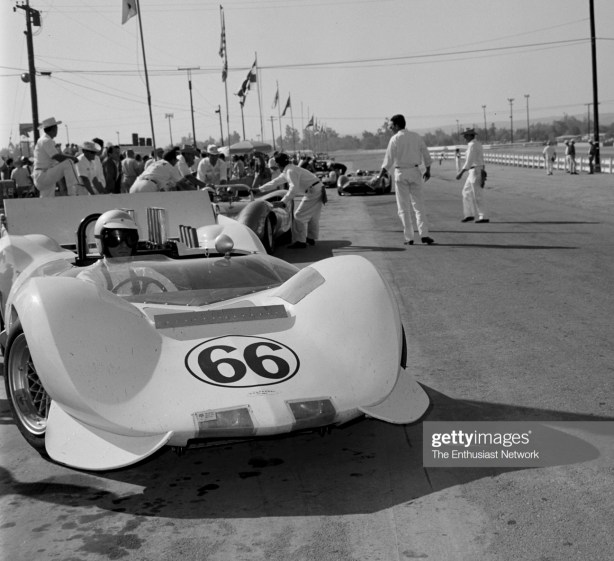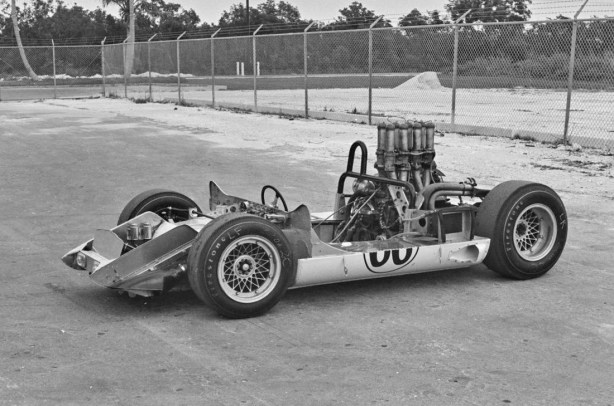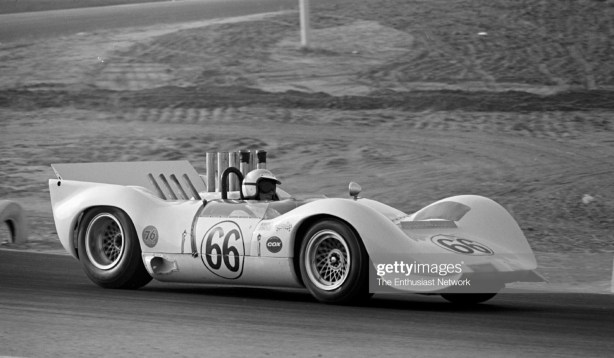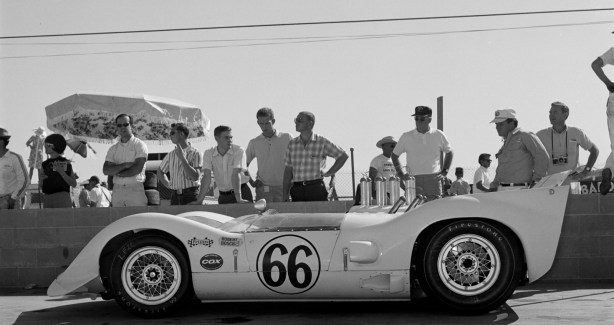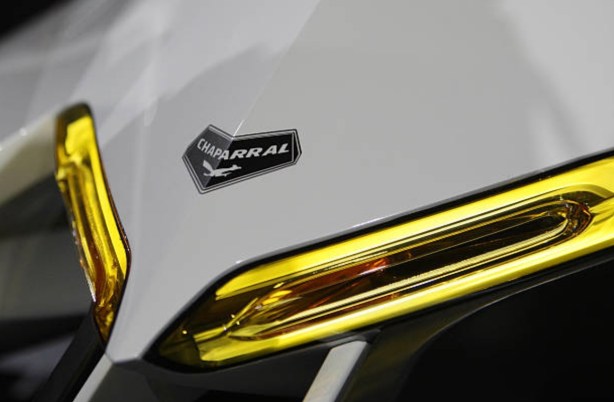Jim Hall on the front row of the grid, a locale he became quite akin to and fond of in 1964/1965- Laguna Seca in May 1965, Chaparral 2A Chev…
1965 started fantastically for the boys from Midland, Texas with a mighty win over twelve hours at Sebring against the best in the world from Ferrari, Ford, Porsche and the rest- Jim Hall and Hap Sharp took pole, fastest lap and the victory.
The team contested the US Road Racing Championships using the fibreglass chassis 2A Chev- those cars in 1964 won Corry Fields, Laguna Seca, Watkins Glen, Meadowdale and Mid Ohio- Jim Hall took the chequered flag in all of these events with the exception of Mid Ohio when his Chaparral business partner, Hap Sharp triumphed.
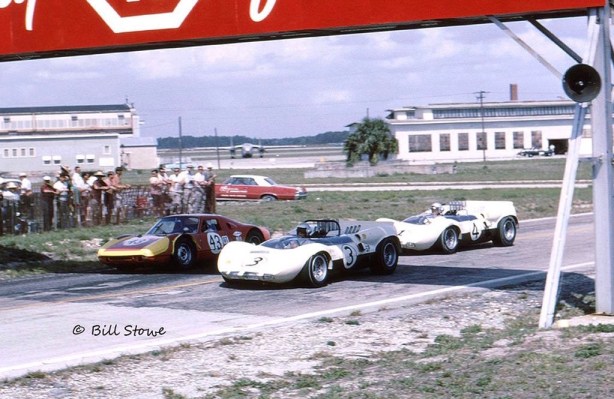
Sebring 12 Hour 1965- MG Bridge, the Hall/Sharp winning Chap 2A Chev goes inside the Ryan/Tidwell Porsche 904, behind is the second Hissom/Jennings Chap 2A, the famous deluge of rain which pretty much flooded the place is yet to come ( N Smuckatelli)

Jim Hall and Dan Gurney, Chaparral 2A Chev and Lotus 19B Ford during the LA Times GP at Riverside in October 1964 (E Rickman)
In 1965 the Chaparral rout started at Riverside in May when Jim again won and continued through Laguna Seca, Bridghampton and Kent in early August before Hap won at Continental Divide and Mid Ohio in the back-half of August before Hall won the USRRC season-ender at Road America in early September.
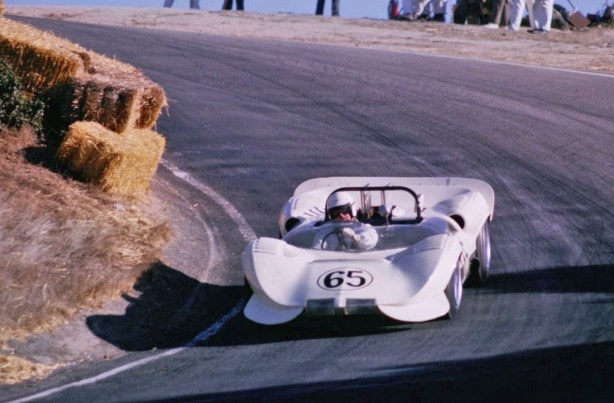
Hap in the Corkscrew on the way to second at Laguna in 1965, Chap 2A Chev, Monterey GP in October (W Hewitt)
On 10 October 1965 the more conventional aluminium monocoque 2C Chev made its debut, and won in Jim Hall’s hands at Kent, the 2C formed the basis of the 2E 1966 ‘definitive’ Can-Am challenger. For 1966 the highly popular, successful and growing popularity of sportscar racing in the United States was recognised with the creation of the first Can-Am series all of us got to know and love even across the other side of the Pacific.
Chaparral campaigned the 2E in the Can-Am and 2D Chev coupe in FIA endurance championship events- the team took their first win in that car at the Nürburgring in 1966.
The evolution of the all Chaparral’s, most racing cars for that matter is ongoing, particularly so the lads from Midland in a constant quest for evolution and occasional revolution.
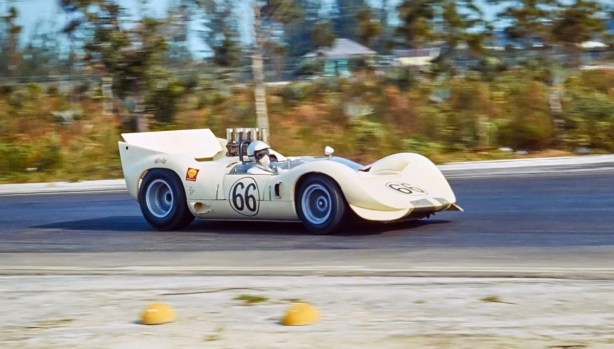
Hall in the 2C Chev during the 1965 Nassau Trophy weekend- led the race until suspension failure when Hap Sharp took over (unattributed)
Traditionally the pro-series of races succeeded the US Road Racing Championship in the latter months of the year with rounds in both Canada and the US. Chaparral opened their 1965 ‘Autoweek Championship’ with a win for Jim in the Canadian Grand Prix at Mosport aboard a 2A in late September 1965- the new 2C made its winning debut at Kent in October 1965- Jim won the Pacific Northwest GP from Hap’s 2A.
At Riverside Hap won in his updated in body 2A, with Jim a non-starter after an accident resulted in suspension damage which could not be made good in time for the 200 mile LA Times Grand Prix. A fortnight later in ‘Vegas Hap won again in his 2A with Jim third in his similar car- Walt Hansgen was second in a John Mecom Lola T70 Ford.
As you will see looking at the various photographs the 2A evolved quite a lot in appearance in from early 1963 to late 1965 and its pretty tricky to pick Hap’s late ’65 fibreglass chassis 2A from Jim’s late ’65 ‘spankers aluminium chassis 2C- see below the wonderful 2A cutaway drawing which inspired this piece.
The cutaway drawing is of the first Chaparral 2 (the A appellation was applied later) which made its race debut during the LA Times GP Riverside weekend of 13 October 1963, so my story should have started about there really, but lets see if we can bridge that gap from this point. So, another nutbag poorly planned piece…
Chaparral 2A and 2C Chev Design and Technical Specifications…
The Chaparral 2A of 1964/5 had evolved enormously from the original car depicted above- the LA Times debutant went like a rocket that weekend leading from pole until sidelined by an electrical fire after four laps despite using off the peg quick solutions such as a Colotti Type 37 four-speed gearbox, Lotus uprights hubs and wheels and front and rear suspension, Cooper steering rack and Girling brakes, not to forget the Chevrolet V8.
Whilst the car was utterly conventional in terms of its suspension front and rear- upper and lower wishbones and coil spring damper units and an adjustable roll bar and inverted lower wishbone, single top link, two radius rods, coil spring damper units an adjustable roll bar using magnesium uprights at both ends- the cars chassis, gearbox and body were far more edgy.
The overall design parameters for the Chap 2 chassis were laid down by Jim Hall and Andy Green of PlasTrend in Fort Worth- Hall plucked Green from the aerospace industry and backed his move to the private sector by becoming his first client- called for an overall weight of 150 pounds and a torsional rigidity of at least 3000 pounds/feet per degree.
The ‘tub’, made of fibreglass reinforced plastic (FRP), comprised pairs of ‘torque boxes’ running down each side connected by bulkheads at each end of the cockpit and extended to the rear suspension mounting points and beyond. It extended right to the cars outside contours (as can be seen in the photographs), up to form the bottom of the door openings, inward to the sides of the Chevrolet V8 and to the drivers elbows and knees in the cockpit. It took full advantage of the sportscar’s overall size to get maximum rigidity from the torque-boxes (the stiffness of a torque box is proportional to its cross-sectional area) and does two jobs in forming part of the car’s outer skin.
At the time of its introduction the chassis was claimed to be the stiffest in motor racing. In the same way that Andrea de Cesaris proved the shuntability of John Barnard’s carbon-fibre McLaren MP4 Ford at the dawn of the eighties- its parent is the Chaparral 2, so too did Jim Hall put it to the test when he used the chassis he damaged at Mosport in late 1964 to win at Sebring in early 1965 partnered by Hap Sharp.
The same principles were applied to the lighter 2C aluminium frame for late 1965 which was closely related to the Chev Corvette GS-2 or ‘actually crafted by Chevrolet’, depending upon your source, we will come to in a little while.
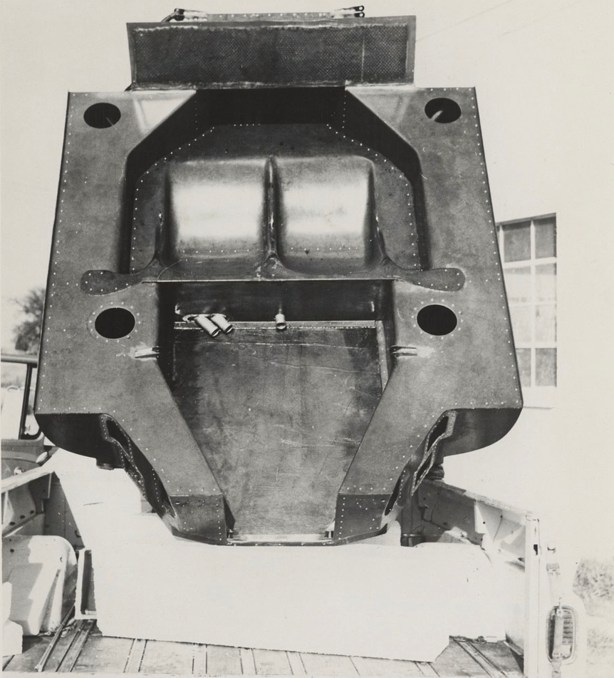
Photograph of a Chaparral ‘fibreglass reinforced epoxy’ chassis from the Library of Philadelphia Collection. ‘…made entirely of fibreglass reinforced epoxy. Moulded in eleven pieces and assembled with an adhesive, the rivets maintaining alignment and gluing pressures. The engine bay is at the bottom with suspension mounting points outboard. Integral seats are above, passenger’s feet fitting into the dark opening at the front (top) of the chassis. The rectangular area will be cut down to form the dashboard cum bulkhead, and in the illustration (ute is justaposed to help with providing an idea of size) hides the front suspension mounting points. The round holes are for access to interior mounting points and the fuel tank…Chaparral designed by Jim Hall…with chassis elements designed and fabricated by Andy Green of PlasTrends…’
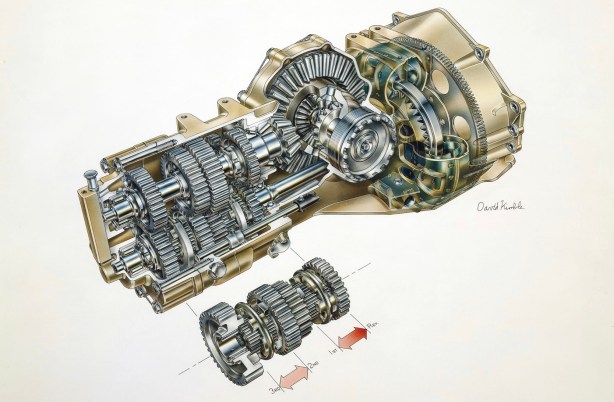
Chevrolet 3 speed and reverse spur gear non-syncro gearbox downstream of a torque converter (D Kimble)
The Chaparral 2 initially used, as mentioned above, a Colotti 5-speed manual gearbox until sufficient testing miles at Rattlesnake proved the durability and performance advantages of a Chevrolet designed and built automatic transaxle, the advantages of which included reliability, avoidance of driver error in terms of missed shifts or over-revs, and reduction in shock-loads to other components in the drivetrain. From a drivers perspective braking can be more accurate without the need to heel ‘n toe
The auto boxes were first raced at Laguna Seca in 1964, Hall and Sharp later claimed that it was only after a discussion between Dave McDonald and Dan Gurney after Mosport three meetings later after they listening to the cars in close company, that Dan asked Hall about the type of gearbox he was using.
The compact Chevrolet made unit comprised a hydraulic torque converter and compact two speed (three speed from the 2E) transaxle usually cast in magnesium. The ‘automatic’ was really operated manually. Before starting the driver engaged first gear and pressed the brakes with his left foot, releasing it upon ‘taking off’- literally. Gear changes to second (and top in the 3 speeder) were made by easing the throttle and moving the gear lever- downshifts were made similarly with a blip of the throttle. Those of us who have lost the use of a clutch have operated our Hewlands similarly. All Chaparral braking was done with the left foot- this left a foot free to operate the ‘flipper’ which we will come to shortly.
Suspension development was continuous from 1963-1965 with all of the bought in components replaced by bespoke Chaparral designed and built items as the performance envelope of the machine increased not least because of advances in polymer chemistry as applied to racing tyres- Chaparral’s ongoing testing of Firestone products provided plenty of valuable input in that regard. Brakes were Chaparral made cast iron solid discs clasped by Girling calipers front and rear.
The wheels were also bespoke, the development of which was first required to get brake temperatures down, the Chaparral spoke-like web structure wheels were strong, light and had a 1.5 inch advantage to the inner-wheel path through which heat radiated. Other advantages were that the bead depression or drop centre, necessary in ordinary wheels to get the bead over the rim flanges was neatly eliminated by making the outer rim flange detachable from the main wheel body- the absence of the depression provided an extra inch and a half on the inside diameter. A further advantage is that the same wheel body was used front and rear, as only the outer rim flange has to be changed to produce a wider rear rim.
See the sequence of photographs below, mainly taken over the Nassau Trophy weekend late each year, from 1961 to 1965 to see the rate of Chaparral technological progress from using someone else’s front-engined chassis in 1960 technological tour de force by 1965, make that 1963!
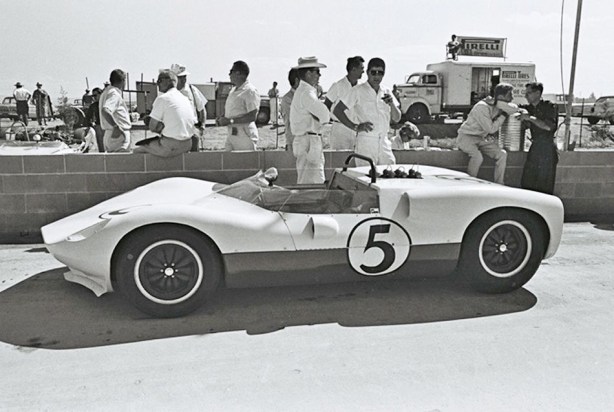
Jim Hall’s brand new Chaparral 2A Chev upon debut during the 1963 LA Times GP 13 October weekend- pole and led until an electrical fire intervened (D Friedman)
Together with the car’s chassis, the Chaparral bodies are of great interest given how visibly they were at the forefront of automotive aerodynamics of the time.
The original 1963 body was based on some Chevrolet wind tunnel data but when tested at Midland the car became very light at 120mph which gave rise to the ‘snow-plough’ air dams first used at Riverside in 1963 and very evident in the Nassau 1963 shot- this solution, Chaparral were the first to do it, was the result of ‘fooling around’ with test track fixes. The team found the approach worked well on smooth surfaces with a ground clearance of circa 2.5 inches from the ground.
The first major redesign of the body was a new front end which solved one problem but gave rise to rear end lift, the solution to which was a vertical lip attached to the rear of the car- a spoiler, it was not an original solution having been first deployed by Ferrari at Sebring in 1961.
As speeds continued to increase more front end lift occurred which was countered by the small appendages shown in many of the accompanying photographs low on nose of the cars on each side- these were first fitted to Hap’s car at Riverside in May 1965- they grew at Mosport a month later into ‘cowcatchers’ of the type seen on steam-locos! These vanes or trim-tabs remained. The rear of the car evolved as well, often in fine detail, with the 2C eliminating the high ducts on the flanks for engine compartment cooling which was discovered were not required.
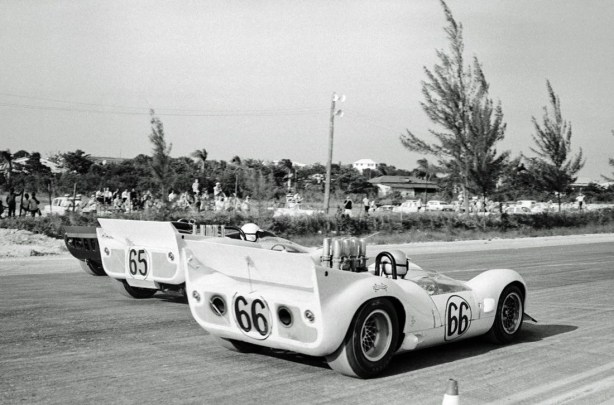
Hall’s #66 2C alongside Sharp’s upgraded 2A at Nassau in 1965. Note the size and pivot for the ‘flipper’ aerofoil, what would later be described as a wing- the mounts either side are ‘fences’ to guide the airflow where it was required. Bob Bondurant’s Lola T70 is just in shot (A Bochroch)
The movable spoiler or ‘flipper’ attracted plenty of attention at the time- it was introduced on Jim’s new 2C and fitted to Hap’s 2A- the aerofoil was mounted between two fins either side of the car, the angle of which was pivoted by the action of the a pedal using the drivers (available) left foot. On the straights it was flat- parallel to the cars body, in corners inclined. An extra master cylinder, a small pedal to the left and a hydraulic piston comprised the actuating mechanism. The default setting was of course the safe one- ‘up’, to exert maximum downforce.
So equipped, the 2C won its first race but Jim was bothered by the deterioration in road holding caused by the much stiffer springs needed to resist the high levels of downforce generated- a case of solving one problem and causing another! Over that Winter of 1965-6 he and his engineer friends at Chevrolet worked out a way to mount the wings directly to the rear suspension uprights thereby bypassing a sprung chassis and permitting a return to ‘more supple’ springs- the dramatic 2E.
At the time the aerodynamics of very fast cars travelling over 150mph was limited, Hall wryly observed ‘…very few people know much about automobile aerodynamics, especially in the 150-200mph range but have strong opinions because they held their hand out the window of the family car once’! Wind tunnel tests provided some information but didn’t then reproduce what is happening under the car. In a tunnel there was no relative speed between the cars underside and the road surface and the wheels were usually not turning in an aerodynamic test. Hall operated on the basis of data obtained from tests at Rattlesnake…all of this is somewhat prophetic given the short period of five years which was to elapse from the time of this 1965 interview with Jim Hall and the 1969 developed 1970 raced staggering, revolutionary 2J Chev ground effect ‘Sucker’ Vic Elford and Jackie Stewart raced in the 1970 Can-Am.
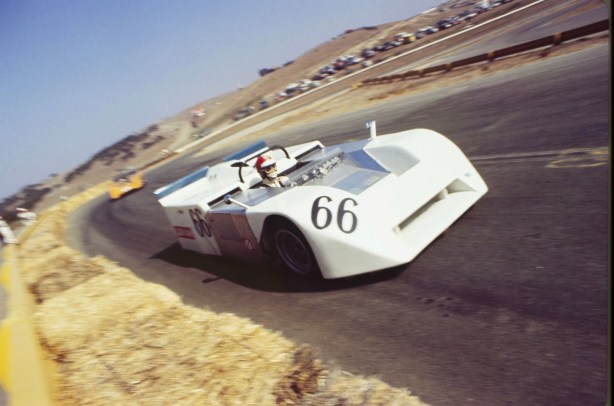
Vic Elford in front of one of the McLaren M8D Chevs at Laguna Seca in 1970, Chaparral 2J Chev, a package with bristles with innovation and original thinking from every pore (Getty)
When discussing most Can-Am cars of the period much of the narrative is around the engines used given the chassis and aerodynamics of most of the customer cars at least, were ‘pretty similar’- not so with the Chaparrals given the chassis (sometimes), ‘automatic’ transmission and aerodynamics where the ubiquitous Chev engines were secondary but of course whilst they were Chevs, they were trick ones…
At the time it was said ‘Chaparral are having less Chevrolet engine trouble than anybody else’s cars’- Sharp and Hall attributed that to their engines being more nearly stock than any of the others! Mind you they were using aluminium blocks and heads ‘the result of happy circumstances in which Alcoa salesman (at the time) Roger Penske) talked Chevrolet Division into getting hold of the tooling originally intended for Gran Sport Corvette use’. By doing so they saved about 110 pounds over the cast iron engine, but the aluminium block limited them to the stock bore, hence they ran at a capacity of 327cid.
Interestingly and logically since adopting the ‘auto tranny’, the engines were tweaked for a wide spread of torque rather than for outright power- ‘the transmission does not allow nearly constant engine speed to be maintained over a large band of road speeds and because it has only one stepped gear reduction there isn’t a chance to keep the engine in a narrow speed band by changing gears often.’
Hall and Sharp said the engines used many standard parts- handy as they had just bought the Midland Chev Dealership at the time! Pistons were standard but for a stress relieving hole drilled at each end of the slot in the oil-ring groove to stop cracks. Also stock were the crank, main bearings and rods with all reciprocating parts sized, balanced and very carefully assembled. At the time the engines were good for circa 415bhp @ 6800rpm and 380 pounds/foot of torque @ 5200rpm. Proposed for 1966 was a shift to 58mm Webers from the 48s then used. The 327cid Chev designed aluminium V8, or 5360cc if you like, had a 4/3.25 inch bore/stroke, Chaparral modified it used a compression ratio of 10:1, Bosch ignition and four Weber 146 HCF 5 carburettors
With the constant evolution of the three 2s (it’s only in more recent times the 2A appellation has been applied) they gradually porked up a bit in weight- but getting faster in the process and ‘nicer to drive’ as Hall put it. They decided upon an aluminium chassis for the 2C to get the weight down albeit the chassis ‘was of the same basic design’- as a consequence the ally tub was 70 pounds lighter than the fibreglass ones and the overall all up car weight of the car 100 pounds lighter.
Interesting at the time- as subsequent events proved neither Hall or Sharp were ‘completely sold on aluminium yet’ raising concerns about the crash safety merits of the two materials observing an accident would inevitably destroy the whole aluminium frame whereas a ‘plastic one can be repaired by bonding in new pieces’ but Hall didn’t profess to know about what was safe and what was not in an accident.
The sportscars.tv article concludes ‘…this then is a brief summary of development to date. Central to the story is the fact that the car has remained adequately fast for two years instead of the usual one. No really drastic changes have been made, but the evolutionary process has been such that today’s Chaparral 2C doesn’t look that much like that original 2.’
‘When the first 2C appeared at Kent, Washington in September 1965 there was anticipation that the new car would be revolutionary whereas the 2C ‘really isn’t the new car but a refinement of the 2 but gets the C suffix as its builders thought the changes were significant enough to warrant that descriptor.’
The central body of the 2C is lower than the 2, the guards are of the same height. The body width was cut by six inches, the front and rear suspension geometry was modified a tad for more anti-dive, lift and squat. ‘A total of 100 pounds has been saved by the use of the aluminium chassis, and all the latest body revisions are incorporated, but it is not nearly as significant as will be the Chaparral 3 when it appears though we make no pretence of knowing when that will be…’ the author wrote.
Perhaps this is the revolution referred to above!- at least the 1966 one anyway. Jim Hall’s patent application drawing for ‘Aerodynamic spoiler for automotive vehicles’ of 15 July 1969 to protect the intellectual property expressed in the 1966 Chaparral 2E Chev. Note the names of the designers- Jim, Jerry Mrlik, James Musser and Frank Winchell.
Chaparral 2A mechanicals…
The bunch of shots above are of the Chaparral 2A #001 during its first race meeting- the 1963 LA Times GP 200 miler at Riverside over the 13 October 1963 weekend.
Tests at Midland in this chassis with a Buick engine initially, and then the Chev have already resulted in the spoilers at the front to keep the car on the ground. The new machine started from pole and was leading when retired.
Nice shot showing the overall layout of the car and big, strong fibreglass chassis, plenty of interest from the punters not least John Surtees at right thinking ‘How am I going to explain a plastic car on pole to Enzo?’.
Mickey Thompson and Jim. Happy with the speed of their steed no doubt.
Notice the way the chassis goes all the way to the back of the car to support the engine and Colotti Type 37 4-speed gearbox, suspension Lotus based inclusive of uprights and wheels at this stage.
Front suspension from above as per text- upper and lower wishbones and coil spring/dampers. Steering rack is Cooper, fuel tank filler open, again note the chassis.
Rear suspension detail, note the spare wheel- Lotus ‘Wobbly-Webs’.
That front end is savage on the eye, data from Chev upon which it was based fell short- the radical front spoilers were a fix improved upon by the first new nose shown throughout this article. Nice cockpit shot and aluminium Chev small block.
Final shot of 2A #001 in its earliest form is a month and a bit later in the December 1963 Nassau Oakes Field paddock.
Franz Weis sets to on Roger Penske’s 2A at Nassau in 1964.
Jim and Sandy Hall are there too, this is a post race shot where the cars suspension is being repaired in-situ. Penske took over Sharp’s car during the mandatory pitstop and they shared the win. Note the spoiler is inserted into a slot in the tail, located by fasteners.
With Jim Hall’s arm in a cast Penske drove the second team car at Nassau- here in the course of pre-event preparation, Roger slipped off the track in the rain- breaking the car’s suspension- thanks to Hap’s generosity Roger shared the win. Notice the fibreglass chassis, ‘stack pipes’ and wheels.
2A, same theme in the Sebring pits in 1965 before Jim and Hap go out and whip all the big guys. Hall is on his iPhone by the wall amongst the spare wheels- they raced two cars that weekend.
Note in particular the ‘plastic fantastic’ full monocoque chassis, of which we get a really good gander- it goes right to the back of the car to which everything is affixed, none of yer load bearing engines et al here.
Big steering wheel, small light above the roundel to illuminate number 3, inspection/access cover open below the coolant top tank, lotsa pipes- both inlet (Weber carbs) and outlet, big cast iron disc and that GM automatic transmission covered out of secrecy or fun…Marvellous, the more you look, the more you see.
Hap Sharp’s 2A in the Riverside paddock, LA Times GP meeting in October 1965.
You can do your own compare and contrasts over the ensuing twelve months from Nassau in late 1964 but the front winglets, copious venting of the guards to allow trapped air to escape and plenty more rubber on the road are obvious.
Nice shot of Hap Sharp with Jim Hall behind him, again at Riverside in October 1965.
Note the front winglets on Haps 2A and Jim’s 2C but the absence of the guard venting on the latest 2C compared with the earlier car. Hap’s also has the huge vent taking lotsa air into the cockpit which I guess is a driver preference thing. These close-up shots are gold really if yer get yer rocks off on this kinda minutae…
Chaparral 2C mechanicals…
Jim Hall and his new 2C in the Riverside pitlane in October 1965.
Bob Tronolone took the shot above of Hap and then walked a few metres and captured Jim.
So the compare and contrast is of Hap’s ‘ultimate spec’ 2A and Jim’s new 2C- the chassis are different, bodywork similar, noting the comments above about the front guards- both machines are fitted with the movable rear ‘flipper’.
2C Nassau 1965 butt shot above and then this splendid ‘in all of its naked glory’ photograph again at Nassau below.
These big-block American iron are such enormous, heavy muvvas one gets a very clear sense of the packaging challenge. It doesn’t matter how low you can mount the thing in your you-beaut monocoque, 327cid of V8 still sits in the air like a country-long drop dunny!- mind you, half the height is inlet manifolds and carbs.
I think of these wheels as archetypal Chaparral! What a gorgeous but brutal instrument of war- during the race the right front suspension failed, the car left the course damaging the rear suspension and tub as well. The latter wasn’t too bad though being rebuilt as the first 2E- tagged 2E-001.
Jim aboard the 2C at Riverside in October 1965 during the LA Times GP 200 mile race.
Etcetera…
In the best of clever racing tradition, making use of what you have- and what still works the mix ‘n match of Chaparral 2 chassis is as follows;
#2A-001 reconstructed into 2D-001
#2A-002 reconstructed as 2D-002 (1966 endurance coupe), then 2F-001 (1967 endurance coupe) and ultimately restored as it began- 2A-002, no doubt some of you lucky folks have been thru the Chaparral Museum
#2A-003 reconstructed into 2F-002
#2A-004 chassis unused
#2C-001 reconstructed into 2E-001 (1966 Can-Am car) then later used as 2G (1967 Can-Am car) and restored as 2E
#2E-002 destroyed in Jim Hall’s accident 1966
#2H restored as was, 1969 ‘unloved by John Surtees’ Can-Am car
#2J restored as was, 1970 Can-Am ‘Sucker-Car’
#2K 1980 Indy winner restored as such
Superb looking racing car- 2C Chev in the LA Times GP Riverside pitlane in 1965.
Bibliography…
‘Can-Am’ Pete Lyons, sportscars.tv article ‘Chaparral 2C – Work Leading To’
Photo Credits…
Getty Images- Eric Rickman, Toby Palmieri, John Christy, T&E Fornander, David Friedman Collection, gtplanet.net, chaparral.com, Eric della Faille, Albert R Bochroch, William Hewitt, Nigel Smuckatelli, Karl Ludvigsen, Kenneth Breslauer
Tailpiece:
Oh for a future of substance for Chaparral…
Finito…
